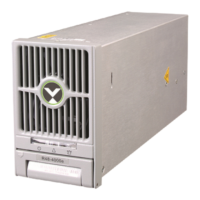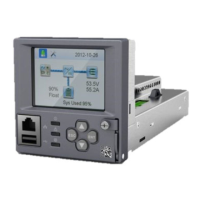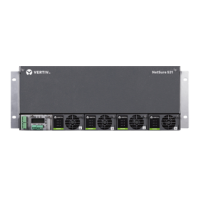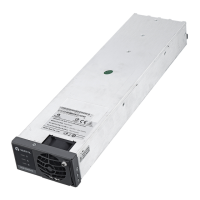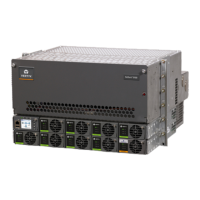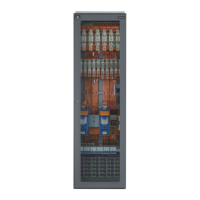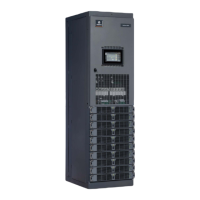NetSure
™
Control Unit (NCU)
User Manual, UM1M830BNA
Spec. No: 1M830BNA, 1M830DNA Code: UM1M830BNA
Model No: M830B, M830D Revision M, May 12, 2017
Capacity Discharge based operation is intended for sites utilizing
only DC powered cooling (heat exchangers, etc.). The cycle period
is determined by User selectable depth of discharge (DOD) of the
batteries per cycle, and associated recharge time. It provides
optimum Hybrid fuel saving operation.
Operation from Grid Power is performed with both Fixed Daily
Time and Capacity Discharge modes of operation. Grid power is
always given priority when available.
As the two types of control are specific to the hardware
configuration of the site, the Fixed Daily Time or Capacity
Discharge is a User selectable option on installation.
Hybrid Operation
Generator Control: A potential free relay contact output from the
NCU interface board controls the start and stop of the diesel
generator. The signal will be generated by the NCU and operates
according to the Hybrid software mode of operation. The control
logic is as follows:
Energized Output Relay - Generator OFF
De-energized Output Relay – Generator ON
This is a fail-safe logic to ensure generator operation in all cases
where power or control to the relays is lost.
In addition, the type of signal to the Generator can be selected as
N/O (Normally Open) or N/C (Normally Closed) by selecting the
relevant output pins of the control relay.
Number of Generator Control Outputs: The NCU Hybrid software
can control one or two generators. Each generator control is
designated as DG1 or DG2 output. The User can select DG1, or
DG2, or DG1 and DG2. When both are selected they will be
alternatively used (two generators operation).
Diesel Fail Alarm: A diesel fail alarm will be generated if the Diesel
Generator ON signal fails to bring the generator to operation and
provide the system with AC power. Alarm will be triggered after
60 seconds (default value, settable) from ON signal. If two
generator operation is selected, the second Diesel Generator ON
signal will be activated simultaneously with the Diesel Fail alarm.
Battery Fuse Trip Alarm: In the event of a Battery Fuse trip
condition, an alarm will be generated.
Under Voltage Alarms:
Under Voltage Alarm 1: If voltage decreases below the
Under Voltage Alarm 1 setting, an alarm is raised.
Under Voltage Alarm 2: If voltage decreases below the
Under Voltage Alarm 2 setting, the Diesel Generator is
started and an alarm is raised.
LVD 1: Normal loads are disconnected.
LVD 2: Priority loads are disconnected.
Charge Voltage: Refer to Figure 6.
Equalize Charge: The battery will be recharged at the equalize
voltage. This is the voltage set in the initial phase of battery
recharge. See Figure 6.
As the voltage limit is reached, the charge current is gradually
reduced – this effect is known as current tail. When the current tail
falls below a threshold level, additional equalize charge time is
added and then the recharge ends.
The equalize charge current tail threshold is settable from 0.002 to
0.02. Default setting is 0.01 (1 A per 100 Ah). The additional
equalize charge time is settable from 1 hour to 24 hours (settable
in minutes from 0 to 1440), default setting is 3 hours. The
duration of the equalize charge is the time from the start of the
recharge to the end of the additional time. (Maximum charge
time, determined from the time charge starts, is settable in the
range of 1 hour to 48 hours, default setting is 18 hours).
The end of recharge is determined by a three (3) step approach:
Step1 - calculated battery capacity exceeds 90%.
Calculation is performed by measurement of battery
current and time, in Ah.
Step 2 - charge current tail threshold is reached.
Step 3 - additional charge time is completed.
Float Charge: Default float voltage is 54.0 V at 20°C with a
temperature compensation of 72 mV per °C.
If battery temperature exceeds 38°C (should be Very High
Temperature alarm), the charge voltage is reduced to 48 V to
reduce gassing and prevent thermal runaway. The same is
applicable as well for equalizing charge.
Equalizing Charge Cycle: As the cyclic use does not ensure
complete battery recharge after every cycle, an equalizing charge
cycle is added. The equalizing cycle is settable for every 2 to 365
days intervals, default setting is 100 days. Equalizing charge time
is 12 hours independent of discharge time setting. Equalizing
charge is performed at equalize voltage until end of additional
equalize time and thereafter at float voltage for the remaining
time. Also see Figure 6.
Equalize charge independently settable 0-1440 min (already set in
equalize charge).
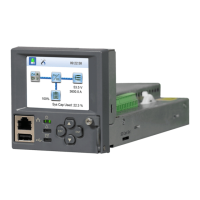
